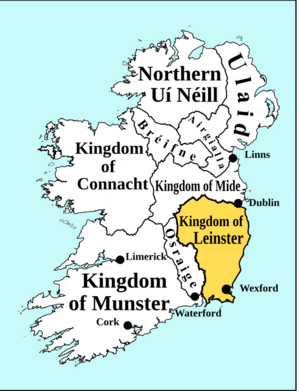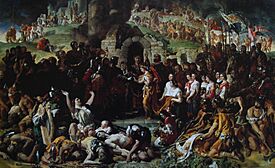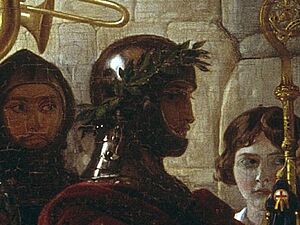Richard de Clare, 2nd Earl of Pembroke facts for kids
Quick facts for kids
Richard de Clare
|
|
|---|---|
|
Richard de Clare, also known as Strongbow
|
|
| Born | 1130 |
| Died | 20 April 1176 (aged 45 or 46) Dublin, Ireland
|
| Resting place | Christ Church Cathedral, Dublin |
| Spouse(s) | Aoife MacMurrough |
| Children | Gilbert de Clare, 3rd Earl of Pembroke Isabel de Clare, 4th Countess of Pembroke |
| Parent(s) | Gilbert de Clare, 1st Earl of Pembroke Isabel de Beaumont |
Richard de Clare (born 1130 – died April 20, 1176) was an important Anglo-Norman nobleman. He was known as the 2nd Earl of Pembroke. He was also the Lord of Leinster and a chief judge in Ireland. Richard is most famous for leading the Anglo-Norman invasion of Ireland. People often called him Strongbow.
After Richard's son, Gilbert, died young, Richard's daughter Isabel inherited his titles. She later married William Marshal.
Contents
Who Was Strongbow?
Richard de Clare was born in 1130. His father was Gilbert de Clare, the 1st Earl of Pembroke. His mother was Isabel de Beaumont. Richard also had a sister named Basilea de Clare.
Richard's father died around 1148. Richard was about 18 years old when he took over his father's lands. However, King Henry II did not fully recognize Richard as the Earl of Pembroke. This was because Richard had supported Henry's mother, Empress Matilda, during a civil war. So, people often called Richard "Count Striguil" instead. This name came from his fortress in Striguil, Wales.
Why the Nickname "Strongbow"?
Richard de Clare is widely known as Strongbow. This nickname became popular much later. In old documents from the 1300s, he was called "Stranghose." This might have been a different spelling of "Striguil." By the 14th century, the name changed to "Strongbow."
Richard's Role in Ireland
The Start of the Invasion

In 1167, the King of Leinster, Dermot MacMurrough, lost his kingdom. He had been removed by Rory O'Connor, the High King of Ireland. Dermot had kidnapped a woman named Dervorgilla 15 years earlier. To get his kingdom back, Dermot traveled to England to ask King Henry II for help.
King Henry II gave Dermot a letter but no soldiers. Dermot then met Richard de Clare and other lords in Wales. Dermot and Richard made a deal. If Richard helped Dermot get Leinster back, Richard could marry Dermot's oldest daughter, Aoife. Richard would also become the next king of Leinster. Richard asked King Henry II for permission to go to Ireland, and the king agreed.
The Campaign in Ireland
Richard and Dermot gathered a large army. This army included skilled Welsh archers. The army sailed to Ireland and captured important towns. They took Wexford, Waterford, and Dublin between 1169 and 1170.
On August 23, 1170, Richard sailed to Ireland to join his forces. However, a messenger from King Henry II arrived to stop him. Richard ignored the king's order and sailed anyway.
After Dermot's Death
Dermot MacMurrough died in May 1171. His son, Donal MacMurrough, claimed the kingdom of Leinster. But Richard also claimed the kingship because he had married Aoife. Richard sent his uncle to King Henry II to calm the king down. Henry was worried about Richard's growing power in Ireland.
King Henry offered to give Richard back his lands in England, France, and Wales. In return, Richard had to give up the lands he had conquered in Ireland. Richard agreed. He gave Dublin, Waterford, and other forts to King Henry. Richard only kept Kildare.
King Henry II came to Ireland in October 1172. He stayed for six months. He placed his own soldiers where they were needed. Both the Irish and Norman lords accepted his rule. Richard and Henry's relationship improved. Richard even helped Henry during a rebellion in France in 1173. As a reward, Richard got his possession of Leinster back. In 1174, Richard tried to move into Munster but was defeated in the battle of Thurles.
Richard's Family and Legacy

Richard de Clare had two daughters from an earlier relationship:
- Aline de Clare, who married William FitzMaurice FitzGerald.
- Basilia de Clare, who married Robert de Quincy.
On August 26, 1171, Richard de Clare married Aoife MacMurrough in Waterford. They had two children:
- Gilbert de Clare, 3rd Earl of Pembroke, who died young in 1185.
- Isabel de Clare, 4th Countess of Pembroke, who became Countess of Pembroke after her brother died. She held the title until her own death in 1220.
Death and What Happened Next
Richard de Clare died in June 1176. He passed away from an infection in his leg or foot. He was buried in Holy Trinity Church, Dublin. His uncle-in-law, Laurence O'Toole, the Archbishop of Dublin, was also buried there.
King Henry II took control of Richard's lands. He made sure Richard's children would inherit them safely. Richard's wife, Aoife, was given her dower rights. She might have held the Striguil lands for a while.
Richard's son, Gilbert, inherited his titles first. But Gilbert died when he was still a child. So, the inheritance then went to Richard's daughter, Isabel. King Henry II and his son, Richard the Lionheart, wanted Isabel to marry William Marshal. William then became the Earl of Pembroke through his marriage to Isabel.
Images for kids
-
Strongbow's tomb at Christ Church Cathedral, Dublin. The current tomb is not the original.




